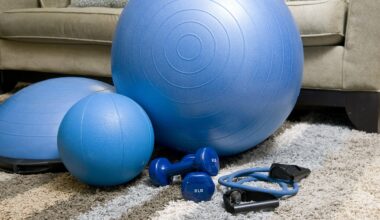Common Mistakes in Swimming
When it comes to swimming, various common mistakes can hinder an athlete’s performance and learning. One prevalent issue is poor body alignment in the water, which leads to increased drag and inefficiency. Swimmers, especially beginners, often struggle to keep their bodies horizontal, resulting in a significant loss of speed. Another critical mistake involves incorrect breathing techniques. Inhaling and exhaling at the right moments is vital for maintaining rhythm and energy while swimming. Additionally, many swimmers fail to engage their core muscles, which are essential for stability and propelling through the water. Coaches must identify these mistakes quickly and work with swimmers to correct them effectively. Watching for common errors such as these helps in improving performance and overall experience in swimming. Swimmers need to understand the importance of proper technique and the direct impact it has on their progress. Addressing these mistakes early on can prevent bad habits from forming and foster a successful swimming journey. Coaches should not only focus on stroke correction but also work on enhancing swimmers’ awareness of these crucial elements.
Correcting Body Alignment
Correcting body alignment is essential for any swimming coach aimed at improving their athletes. Coaches can implement drills that emphasize maintaining a horizontal position in the water. For example, practicing streamline positions before swimming strokes allows swimmers to understand the correct body posture. Additionally, the use of kickboards during drills can help train swimmers to develop proper alignment. Instructing athletes to engage their core while swimming enhances their stability and allows for smoother strokes. Coaches should observe each swimmer closely, providing real-time feedback to ensure they are maintaining proper form. Including strength training that addresses core stability and flexibility within the training regimen is beneficial. Swimmers can also benefit from filming their technique underwater, allowing them to visually assess and correct their positioning. This approach fosters a deeper understanding of body alignment issues. Coaches can encourage athletes to visualize maintaining a straight line from head to toes while swimming, reinforcing the importance of alignment. This holistic approach helps swimmers achieve better alignment, ultimately enhancing their speed and efficiency in the water.
Enhancing Breathing Techniques
Breathing techniques play a vital role in a swimmer’s efficiency and endurance. Many swimmers struggle with proper breathing timing, often leading to disrupted strokes and loss of speed. Coaches should focus on teaching swimmers when to inhale and exhale to maintain a smooth rhythm throughout their strokes. Emphasizing bilateral breathing can offer swimmers a balanced stroke and improve their overall performance. Techniques such as the ‘bubble, breath, and stroke’ method can help swimmers learn how to breathe without interrupting their fluid movement. Additionally, practicing drills like the “catch-up” drill can help swimmers perfect their breathing patterns. Using equipment such as snorkels has also gained popularity, as it allows swimmers to concentrate solely on their stroke mechanics without worrying about breathing momentarily. Coaches should work on building swimmers’ comfort in the water, as anxiety often compels them to rush their breathing. Encouraging relaxation is essential for effective breathing. Providing a structured set of practice routines focusing on breathing allows swimmers to perfect their techniques over time. Ultimately, consistent reinforcement helps swimmers develop confidence and flows during their strokes.
Importance of Core Engagement
Core engagement is a crucial factor in swimming technique that many swimmers often neglect. A strong core enables better body control, stability, and propulsion through the water. Coaches should educate swimmers about the significance of core muscles and how they contribute to overall swimming performance. Incorporating specific exercises targeting core strength into training sessions is an effective way to boost performance. Drills such as planks, flutter kicks, and medicine ball rotations can significantly enhance core stability. By enhancing core engagement, swimmers can reduce drag and improve stroke efficiency. Coaches must also encourage swimmers to focus on maintaining a steady core throughout their swimming sessions. This can be done through a variety of training routines emphasizing core integration with strokes. Simple reminders during workouts to engage the core can reinforce its importance. Additionally, coaches should reinforce the idea that improved core strength translates to stronger turns, starts, and finishes. During practice, athletes should feel comfortable actively engaging their cores, as it enhances their overall performance, making swimming less fatiguing. Establishing a balance between strokes and core strength ultimately leads to impressive performance.
Addressing Common Habits
Addressing common swimming habits is essential for coaches who want to cultivate effective swimmers. Many athletes develop habits that are counterproductive, such as overreaching in their strokes or resting too much during turns. These habits can lead to inefficient swimming and slow progress. Coaches need to identify these habits and implement strategic interventions through observation and regular feedback. Providing swimmers with structured drills encourages attention to technique rather than repetitive motions that reinforce errors. For example, using drills that emphasize hand entry during freestyle can help modify a swimmer’s strokes. Additionally, engaging swimmers in discussions about their goals aids in understanding the significance of correct habits. Coaches should remind swimmers to remain present during practices, focusing on continuous improvement. Encouragement paired with constructive feedback creates a positive learning environment. Creating a sense of accountability among teammates helps push each swimmer to correct their habits for the benefit of the group. Emphasizing the importance of refining technique contributes to overall growth in swimmers’ abilities. Developing a culture that promotes awareness of habitual errors will help swimmers overcome challenges and improve overall performance.
Utilizing Technology for Improvement
In today’s digital age, utilizing technology can greatly enhance swimming coaching techniques. Tools such as waterproof cameras can provide instant feedback and allow swimmers to observe and analyze their own techniques in real-time. Coaches can use video analysis to identify common mistakes in stroke execution and body alignment, making it easier to provide targeted corrections. Apps and software designed for swim training can track swimmers’ performances and assess their progression over time. Incorporating wearable technology, like heart rate monitors, enables coaches to evaluate swimmers’ fitness levels, ensuring training intensity aligns with their overall goals. Online platforms also offer athletes access to instructional and motivational content, including videos featuring elite swimmers. This creates an opportunity for athletes to visualize techniques and learn from the best. Additionally, coaches should remain updated on the latest technological advancements in swimming, attending workshops or webinars on innovative coaching methods. By integrating these technologies into coaching methods, athletes benefit from enhanced training and can progress faster under expert guidance. The combination of technology and traditional coaching reinforces the development of swimmers and contributes to their success.
Conclusion: Path to Improvement
In conclusion, addressing common swimming mistakes and correcting them through effective coaching is vital for athletes’ success and development. Coaches play a key role in identifying issues like body alignment, breathing techniques, core engagement, and habitual errors. Implementing tailored drills that foster improvement in these areas creates a solid foundation for swimmers. The integration of technology into coaching strategies further enriches athletes’ training experiences and enhances performance. It’s essential for coaches to cultivate an environment that promotes awareness and encourages feedback among swimmers. This leads to a progressive and supportive learning environment where athletes feel comfortable striving for excellence. Consistent reinforcement of proper techniques, combined with continuous practice, helps swimmers avoid developing bad habits. Emphasizing the importance of core strength, breathing, and alignment enhances efficiency and performance in the water. In building a strong relationship between coach and swimmer, athletes feel empowered to grow and flourish in their swimming careers. With patience and persistence, both swimmers and coaches can navigate the path towards improvement, leading to remarkable achievements in the pool.
Continuous Learning and Adaptation
Continuous learning and adaptation are fundamental aspects of swimming coaching that influence how effectively athletes develop their skills. Swimming techniques and training methodologies are continually evolving, and coaches must be proactive in keeping up with these changes. This may involve attending workshops, engaging with other swimming professionals, or even pursuing relevant further education. Active engagement in the swimming community offers insights into new training methods and technologies that can be incorporated into coaching practices. Besides training updates, understanding athletes’ psychological states is crucial for coaches. Different swimmers respond uniquely to feedback and coaching styles; hence, adapting instructional methods to suit individual learning styles fosters an inclusive environment. Emphasizing open communication creates trust between swimmers and coaches, enabling a more effective coaching dynamic. Building relationships encourages athletes to ask questions and seek clarification, leading to better overall performance. Fostering a culture of continuous improvement ensures that all swimmers, regardless of their skill level, remain motivated and invested in their training. As the sport of swimming progresses, coaches must remain adaptable to the demands of their athletes and the landscape of the sport itself.


